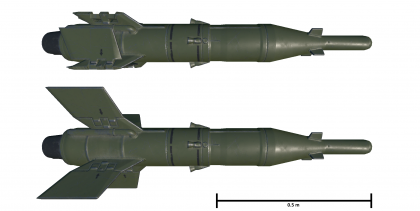Difference between revisions of "HJ-73E"
(→Description: Added weapon image) |
(Adding the history of HJ-73E) (Tag: Visual edit) |
||
| Line 48: | Line 48: | ||
== History == | == History == | ||
| − | + | During the late 1960s was the Sino-Soviet border conflicts, especially at Zhenbao /Damansky Island where Mainland Chinese [[T-62 545 (China)|captured a T-62]] from the Soviet Border Troops, PLA found they were in the lower hand in terms of anti-armor weaponry, especially in ATGM (which, there was none in Mainland China); but a long-time friend of Mainland China- North Korea (DPRK) provided some 9K11 Malyutka (AT-3 Sagger) missiles samples for them and Romania later provided another batch of samples for the Mainland in 1973, they started the story of this old yet sufficient missile's journey in Mainland China service. | |
| + | |||
| + | After multiple departments and research facilities efforts, finally in 1979, HJ-73 has passed state tests and ready to be commissioned in PLAGF. | ||
| + | |||
| + | Later in the 1993, Chinese upgraded HJ-73 into its C modification with an unseen tandem warhead from his Soviet counterpart, eventually this missile became the cornerstone of PLAGF light vehicle's last ditch weapon in case they face any heavily armored targets. | ||
== Media == | == Media == | ||
Revision as of 18:39, 21 June 2021
Contents
Description
HJ-73E (Chinese: 红箭-73E) is a tandem-warhead ATGM based on the HJ-73 (which is a clone of the Soviet's 9M14 ATGM found on BMP-1), first introduced in the 1990s. It changes the guidance method from the original MCLOS to SACLOS, along with enhanced penetration capabilities.
Vehicles equipped with this weapon
- ZBD86 (Modification)
General info
Although the missile shares similarities to its predecessor, HJ-73, in terms of the appearance, the major difference is a probe on the tip of the missile which serves as the tandem warhead of the missile, and thus gives it an whopping overall penetration of 900 mm RHA within its firing range. In addition, it is a SACLOS (mouse-controlled) missile that gives players more control over its guidance.
While there were some improvements over the older models, this missile still suffer from a relatively low velocity (120 m/s, a little improvement over HJ-73's 115 m/s); which means at longer ranges, the enemy might have some time to react over your missile by eliminating the player or the missile itself.
Effective damage
With its 1.83 kg TNT equivalent explosive mass, for lighter vehicles it can cause some blast damage to the hull that might cause hull-breaks; the nature of an ATGM also means it also causes penetration damages from the jet stream, melting anything that is in its way; thanks to the tandem warhead, even the heaviest targets with ERA might face some serious damage from it.
Comparison with analogues
It is unrivalled at its tier with the whopping 900 mm penetration.
Usage in battles
Due to the high penetration of the missile, very few tanks can stand up to it, even in higher tier battles.
But this missile still comes with a few drawbacks, like low explosive mass and longer immure zone (that is, it flies for some distance before guidance); but the most lethal of all, the slow velocity of this missile at 120 m/s (only shines over its predecessor for a mere 5 m/s and the Japanese Type 64 MAT which is infamous for its 85 m/s flight velocity).
There the best way of using this missile is stay behind the front lines and try to find stationary targets since it would be way easier to defeat them and try to stay hidden as long as possible; with the slow velocity of this missile, the player might meet his own end before the missile even impacts on the target.
Pros and cons
Pros:
- Unrivalled penetration of 900 mm RHA at its tier, on par with MIM-146 on ADATS and only come behind 9M133 on BMP-2M
- SACLOS (aka mouse-controlled) missile that can be handled easier than MCLOS.
- Tandem warhead which can defeat ERA-equipped tanks.
Cons:
- Low velocity of 120 m/s.
- Can be countered by the active protection system (APS) found on T-90A and AMX-30B2 BRENUS.
- Low explosive mass.
History
During the late 1960s was the Sino-Soviet border conflicts, especially at Zhenbao /Damansky Island where Mainland Chinese captured a T-62 from the Soviet Border Troops, PLA found they were in the lower hand in terms of anti-armor weaponry, especially in ATGM (which, there was none in Mainland China); but a long-time friend of Mainland China- North Korea (DPRK) provided some 9K11 Malyutka (AT-3 Sagger) missiles samples for them and Romania later provided another batch of samples for the Mainland in 1973, they started the story of this old yet sufficient missile's journey in Mainland China service.
After multiple departments and research facilities efforts, finally in 1979, HJ-73 has passed state tests and ready to be commissioned in PLAGF.
Later in the 1993, Chinese upgraded HJ-73 into its C modification with an unseen tandem warhead from his Soviet counterpart, eventually this missile became the cornerstone of PLAGF light vehicle's last ditch weapon in case they face any heavily armored targets.
Media
Excellent additions to the article would be video guides, screenshots from the game, and photos.
See also
Links to the articles on the War Thunder Wiki that you think will be useful for the reader, for example:
- reference to the article about the variant of the weapon;
- references to approximate analogues by other nations and research trees.
External links
Paste links to sources and external resources, such as:
- topic on the official game forum;
- encyclopedia page on the weapon;
- other literature.




